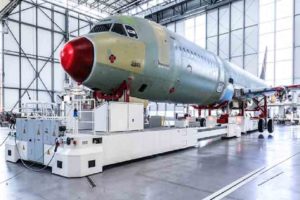Aviation
China’s top 3 airlines will purchase nearly 300 Airbus A320neo aircraft.

China has placed the largest order for Airbus aircraft in their nation, as many other nations have regulated the operations since the COVID dropping of cases. China is coming up with the substantial requirement ahead of the years.
Airbus had previously predicted that the region of China will experience a large demand for aircraft.
It is now obvious that the Chinese aviation industry is recovering and has a promising future after Airbus announced the signing of deals with Air China, China Eastern, China Southern, and Shenzhen Airlines for a total of 292 A320 Family aircraft. Once the relevant criteria are met, these orders will enter the backlog.
“These new orders demonstrate the strong confidence in Airbus from our customers. It is also a solid endorsement from our airline customers in China of the performance, quality, fuel efficiency and sustainability of the world’s leading family of single aisle aircraft.” said Christian Scherer, Airbus Chief Commercial Officer and Head of International.
“We commend the excellent work by George Xu and the entire Airbus China team as well as our customers’ teams for having brought to conclusion these long and extensive discussions that have taken place throughout the difficult COVID pandemic.”
Over 2,070 Airbus aircraft would be in service with Chinese carriers by the end of May 2022.
The latest generation engines and Sharklets used in the A320neo Family jointly save at least 20% more fuel and CO2 while reducing noise by 50%.
The Airbus 18-inch wide seats in economy are a basic feature of the A320neo Family, which provides unrivalled comfort in all classes.
More than 8,000 orders for the A320neo Family from more than 130 customers were in total as of May 2022. Airbus has delivered more than 2,200 A320neo Family aircraft since its Entry Into Service six years ago, reducing 15 million tonnes of CO2 in the process.
2,259 A320neo family aircraft with 127 operators were in operation as of May 2022, 85 of which use CFM engines and 42 of which use PW engines. The top five airlines by number of aircraft operated were IndiGo with 207, China Southern Airlines with 94, Frontier Airlines with 77, China Eastern Airlines with 72, and easyJet with 58. As of May 2022, there have been no accidents involving hull loss or fatalities in the A320neo series.
China’s TP500 freight drone makes its maiden flight.(Opens in a new browser tab)
The Airbus A320neo family of narrow-body aircraft is a development of the original Airbus A320 family. Based on the earlier A319, A320, and A321 (improved variation), which was dubbed A320ceo, for “current engine option,” the A320neo family (neo for “new engine option”) was created.
More than 5.51 million flights over 11 million block hours had been performed without a mishap by the A320neo fleet worldwide.
Deliveries will occur between 2023 and 2027, with the majority anticipated in 2024. According to available tonne kilometres (ATK), Air China estimated its acquisition would result in a 10.4% increase in capacity, while China Southern predicted a 13% rise.
In separate stock exchange filings, Air China and China Southern Airlines announced that they will each purchase 96 aircraft from the A320neo family, valued at $12.2 billion at list prices. It was announced that China Eastern Airlines would spend $12.8 billion to purchase 100 of the same type of aircraft.

Aviation
COMAC Unveils Plans for the C929 to Rival Airbus and Boeing

After the success of China’s first C919 aircraft, the country is setting its sights on developing a larger plane. COMAC (Commercial Aircraft Corporation of China) has officially confirmed plans to build a widebody aircraft, marking a significant step in its aircraft lineup.
Traditionally, Airbus and Boeing dominate the widebody aircraft market, with decades of expertise in developing planes and engines capable of carrying heavy payloads. China, which currently relies on imported engines, is now aiming to challenge these giants with its own widebody jet, the C929, designed to compete with the Airbus A350 and Boeing 777.
American Airlines Is Looking for Flight Attendants: Apply Now
The C929 will be China’s first independently developed long-range widebody aircraft. It adheres to international airworthiness standards and boasts independent intellectual property rights. The baseline version is designed to seat 280 passengers and offers a range of 12,000 kilometers, catering to global demand for both regional and international air travel.
Russia, which also needs reliable narrowbody and widebody aircraft, could become a key customer for the C929. Additionally, China plans to target the broader Asian market as it continues to expand its aviation capabilities.
Close Call at Heathrow: BA Flight Narrowly Escapes Drone Collision
China’s aviation progress includes the ARJ21 (now called C909), a regional jet with 100 seats for shorter routes, and the C919, a narrowbody jet with 180 seats designed to rival the Boeing 737 MAX and Airbus A320. Both models have found increasing demand in the domestic market.
At China’s largest air show in Zhuhai, COMAC announced that Air China will be the launch customer for the C929 widebody jet, though details about order size and delivery timelines were not disclosed.
Other major deals announced by COMAC include:
- Hainan Airlines: Firm orders for 60 C919 and 40 C909 regional jets.
- Colorful Guizhou Airlines: 30 C909 jets, with 20 firm orders and 10 provisional agreements.
The C929, renamed from the CR929 after Russia withdrew from the joint development project in 2023, is expected to carry 280–400 passengers with a range of 12,000 kilometers, competing directly with Boeing’s 787 Dreamliner.
According to COMAC’s deputy general manager, Tong Yu, the first fuselage section of the C929 is expected by September 2027, with prototype test flights anticipated soon after.
-

 Aviation2 months ago
Aviation2 months agoMicrosoft Flight Simulator Raises $3 Million to Bring Back the An-225 Mriya
-

 Airlines2 months ago
Airlines2 months agoQantas Engineers Stage Walkout Over Cost of Living Concerns
-

 Airlines2 months ago
Airlines2 months agoQatar Citizens Can Travel to the United States Without a Visa
-

 Aviation2 months ago
Aviation2 months agoQatar Airways bans these new Electronic Devices on plane
-

 Airlines2 months ago
Airlines2 months agoJapan Airlines Rolls Out Free Domestic Flights to International Passengers
-

 Defence2 months ago
Defence2 months agoWhich Country Has the Largest Fleet of Fighter Aircraft?
-

 Airport2 months ago
Airport2 months agoWestern Sydney Airport Welcomes Its First Plane After 6 Years of construction
-

 Aviation2 months ago
Aviation2 months agoDid you know ? Once Boeing 747 carried 1088 passenger in 1991










